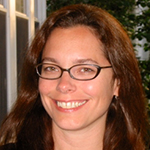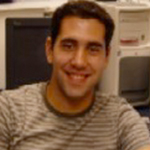Seminars are held at 4:00 PM on Tuesdays in Room F160
on the first floor of the Technological Institute (2145 Sheridan Road) unless otherwise noted
Spring Quarter 2011
| Date | Visitor / Seminar | Host | |
| April 5 |  |
Marcel Agueros In a classic 1972 paper, Andrew Skumanich showed that stellar rotation decreases over time --- as does chromospheric activity, a proxy for magnetic field strength. This relationship between age, rotation, and activity has been a cornerstone of stellar evolution work for over 40 years. However, rotation periods are scarce for stars with ages greater than 500 Myr, complicating the calibration of an age-rotation-activity relation that can be applied to field stars. The Columbia/Cornell/Caltech Palomar Transient Factory (CCCP) survey of open clusters is an effort to systematically map stellar rotation in open clusters. I will present the first CCCP results for Praesepe, a rich, nearby, 600 Myr open cluster. With light curves containing >150 measurements over more than three months, we have measured rotation periods for ~40 K & M-type cluster members. These rotation periods span the gap between the periods measured for the solar-type and lowest-mass Praesepe members, and indicate that the orderly mass- rotation relation seen for higher mass Praesepe members begins to break down at ~0.6 Msun. In addition, I will discuss our on-going effort to complete the portrait of the 600 Myr age-activity-rotation by measuring Halpha emission for cluster stars. | Daryl Haggard |
| April 12 |
 |
Elizabeth Blanton Observations over the last ten years with Chandra and XMM-Newton have shed much light on cooling flows in the centers of clusters of galaxies and the role of AGN feedback. Cooling of the hot intracluster medium in cluster centers can feed the supermassive black holes found in the cores of the dominant cluster galaxies leading to AGN outbursts which can reheat the gas, stopping cooling and large amounts of star formation. AGN heating can come in the form of shocks, buoyantly rising bubbles that have been inflated by radio lobes, and the propogation of sound waves. I will present recent results on AGN feedback, highlighting a very deep Chandra observation of Abell 2052. In addition, I will discuss the use of radio-emitting AGN as beacons for clusters of galaxies at high redshifts, where the radio emission is easier to detect than the optical or X-ray cluster emission. |
Vicky Kalogera |
| April 19 |
 |
David Kaplan Neutron stars are among the densest objects in the universe. The conditions in their centers are largely unconstrained by current theoretical physics or terrestrial laboratories, leaving a wide variety of compositions and structures possible. Observations of thermal emission from neutron stars -- specifically measurements of their sizes and cooling rates -- may therefore be the best way to constrain the behavior of matter in these extreme conditions. I will discuss a sample of nearby, cooling neutron stars that we are using for this purpose. We are attempting to pin down the basic parameters of these neutron stars with a variety of ground- and space-based observations, coupled with theoretical modeling. Along the way, we have encountered a number of interesting astrophysical puzzles that I will describe. |
Vicky Kalogera |
| April 26 |
 |
Nico Yunes The detection of gravitational waves promises to open a new window to the Universe. Detectors on Earth, such as Advanced LIGO and Advanced Virgo, and in space, such as LISA, hope to detect tens to hundreds of events from a variety of sources, prime among which are binary inspirals and mergers during their last parsec of evolution. Earth detectors are sensitive to waves in the deci to kiloHertz range, specially suited to observe solar-mass black hole and neutron star inspirals and mergers. Space detectors are sensitive in the milli-Hertz range, best suited to observe supermassive black hole coalescences in galaxy mergers, as well as extreme-mass ratio inspirals of solar-mass black holes into supermassive ones. These waves carry a wealth of information about the sources that generate them, together with information about the nature of the gravitational interaction. Thus, the detection of such waves will allow us to acquire invaluable astrophysical information, as well as to place the most stringent constraints of General Relativity in the strongest-gravitational regime accessible to observation. In this talk, I will discuss binary inspiral, gravitational wave sources and how their detection can be used to extract astrophysical information and learn about fundamental physics. | Will Farr |
| May 3 |  |
Takeshi Oka The 4 3.5 µm infrared spectrum of H3+ is a new powerful astrophysical probe for studying the Central Molecular Zone (CMZ), a region with a radius of ~ 200 pc at the Galactic center. The simple chemistry of H3+ allows us to determine the product of the ionization rate ? and the pathlength L, and its ideal rotational level system allows us to determine temperature T and density n of the environment. Although H3+ is less abundant than H2 by a factor of 107 108 the intensity ratio between the dipole to quadrupole transitions (?/a)2 ~ 109 overrides this factor to make the infrared absorption spectrum of H3+ much more readily observable than that of H2.
|
Farhad Zadeh |
| May 10 |  |
Dong Lai Recent observations have shown that in many exoplanetary systems, the spin axis of the parent star is misaligned with the angular momentum axis of the planet's orbit. This is unexpected as planets are formed in protostellar disks which are thought to be perpendicular to the stellar rotation axis. Surprisingly, the interaction between a magnetic protostar and its circumstellar disk gives rise to a secular instability, which may result in spin-orbit misalignment following planet formation, even before any additional few-body gravitational interaction takes place. |
Fred Rasio |
| May 16 *Ryan Hall Auditorium 4:00 pm |
 |
Jim Kasting Over 500 planets have been found around nearby stars, plus ~1200 planet candidates around more distant stars (from Kepler), but none of them is thought to be at all like Earth. Some of the Kepler planets could be, but there is no way of telling. The goal now is to identify rocky planets within the habitable zones of their stars and to search their atmospheres spectroscopically for signs of life. To do this, we need new space-based telescopes such as NASAs proposed Terrestrial Planet Finders or ESAs Darwin mission (all of which are indefinitely postponed at the moment). If spectra of extrasolar planet atmospheres can be obtained, the presence of O2, which is produced from photosynthesis, or O3, which is produced photochemically from O2, would under most circumstances provide strong evidence for life beyond Earth. But false positives for life may also exist, and these need to be clearly delineated in advance of such missions, if at all possible. I will also contrast my optimism about the search for complex life with the more pessimistic view expressed by Ward and Brownlee in their book, Rare Earth. |
CIERA Colloquium |
| May 24 |  |
Ellen Zweibel Cosmic rays carry about a third of the energy density in the interstellar medium. They are essentially collisionless and couple to the background gas electromagnetically. I will discuss how the cosmic rays couple, and apply the coupling theory to a model of galactic winds. |
Novak/Zadeh |
| June 7 |  |
Boaz Katz During a supernova explosion, a strong radiation mediated shock (RMS) traverses the exploding stars' mantle/envelope. Once the shock reaches the surface of the star a burst of high energy radiation (UV to gamma-rays) is expected to be emitted. After briefly reviewing the theory of SN shock breakouts, I will focus on recent analytical and numerical calculations of the structure and breakout of fast (v>0.1c) shocks, in which a hard spectrum naturally arises. These results support the breakout interpretation of the flash preceding SN2008D, which had a puzzlingly hard spectrum, and implies that low Luminosity gamma-ray bursts may be explained as mildly relativistic shock breakouts. |
Smadar Naoz |
Past Astrophysics Seminars